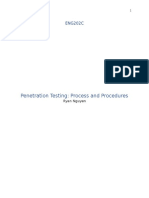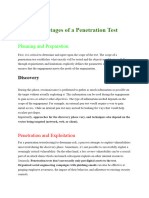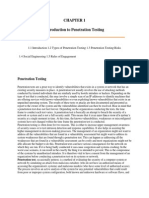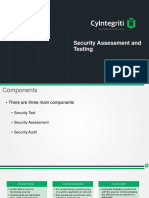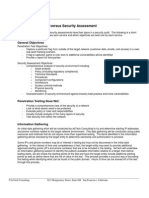0% found this document useful (0 votes)
29 views6 pagesDocument PDF
The document outlines the penetration testing process, which aims to identify vulnerabilities in systems to enhance security. It details various types of penetration testing (Blackbox, Greybox, Whitebox, Red Teaming, and Purple Teaming) and describes the stages involved, including pre-engagement, information gathering, vulnerability assessment, exploitation, post-exploitation, lateral movement, proof-of-concept, and post-engagement activities. Additionally, it emphasizes the importance of documentation, reporting, and remediation in ensuring the effectiveness of the penetration test.
Uploaded by
lokikarai1Copyright
© © All Rights Reserved
We take content rights seriously. If you suspect this is your content, claim it here.
Available Formats
Download as PDF, TXT or read online on Scribd
0% found this document useful (0 votes)
29 views6 pagesDocument PDF
The document outlines the penetration testing process, which aims to identify vulnerabilities in systems to enhance security. It details various types of penetration testing (Blackbox, Greybox, Whitebox, Red Teaming, and Purple Teaming) and describes the stages involved, including pre-engagement, information gathering, vulnerability assessment, exploitation, post-exploitation, lateral movement, proof-of-concept, and post-engagement activities. Additionally, it emphasizes the importance of documentation, reporting, and remediation in ensuring the effectiveness of the penetration test.
Uploaded by
lokikarai1Copyright
© © All Rights Reserved
We take content rights seriously. If you suspect this is your content, claim it here.
Available Formats
Download as PDF, TXT or read online on Scribd
/ 6





